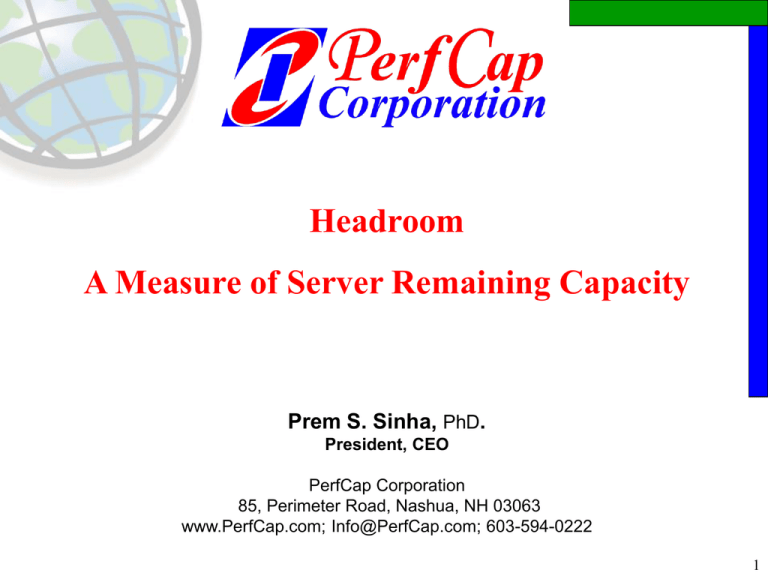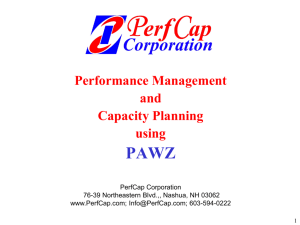Capacity Planning Using Headroom Analysis
advertisement

Headroom
A Measure of Server Remaining Capacity
Prem S. Sinha, PhD.
President, CEO
PerfCap Corporation
85, Perimeter Road, Nashua, NH 03063
www.PerfCap.com; Info@PerfCap.com; 603-594-0222
1
Challenges
• Pro-active Vs. Re-active planning
• Large number of geographically
dispersed systems
• Traditional Capacity Planning
Methodology takes too long
• Automated process – daily basis:
–
–
–
–
Collect/consolidate data
Generate reports
Publish on a web site
Notify – “need to know” basis
2
Capacity Planning
Definition:
A process to determine how much computing resources are
required to meet business growth
Or
How much business can grow before some device will run
out of capacity
To answer “What if” questions like:
– Can my current configuration handle three times of current workload – when will
my current configuration saturate
– What will be impact of a new application on current system performance
– What will be impact of upgrading a current server or adding a new server
– Can I reduce the number of servers with out violating my “Service Level
Agreement” – a.k.a Server Consolidation
3
Sizing Methods
Real
System
Benchmarks
Simulation
Models
Rules
of
Thumb
Analytic
Models
Linear
Projections
Accuracy
4
Capacity Planning via Modeling
Steps:
• Data Collection
• Identifying Peak Interval(s)
• Workload Characterization
• Model Validation
• Saturation Analysis
• “What If” Analysis
5
Capacity Planning via Trending
Performance Metric
(Av. or Peak CPU Utilization)
Capacity Limit
Today
Remaining
Capacity
J F M A M J J A S O N
D
Time
• Simple to produce and follow
• Issues
• defining right Capacity Limit
• single vs composite metric
• end user satisfaction
6
PAWZ Planner
Where do you want to operate?
Response Time
Response Time = S{Service Time + Queuing Time}
Headroom
Saturation Point
Current Workload
l
Workload
7
System Capacity – An Example
A Trading System
10
Response Time = S{Service Time + Queuing Time}
9
Normalized Response Time
8
Significant
performance
degradation
7
6
5
4
3
Today
2
1
Headroom today is ~60%
0
0
1000
2000
3000
4000
5000
6000
7000
8000
9000
10000
Quotes/sec
System capacity is ~8500 quotes/sec.
8
Each Day PAWZ Automatically Models Each
System
to Determine
System Capacity
PAWZ
– Saturation
Analysis
At 125% growth from
Nov. 25th, system will
reach capacity.
-100% is no load.
0% is Nov. 25th load.
Headroom is 55% of capacity
9
PAWZ Maintains Trend of Daily Headroom
To Forecast Decline of to Critical Level
10
Still not enough …
Problem:
Not enough time to examine response time
curves or headroom trends for many systems:
Solution:
Risk Analysis provides high-level overview
of headroom trends of all systems.
11
Risk Analysis
• Need to know how soon headroom will
reach a given level.
• Daily risk state determined by time left until
headroom will decline to user-defined
thresholds.
• Risk states for multiple systems displayed
as color status (red, green, amber) counts.
12
Headroom Risk Analysis
Headroom reaches 0
Headroom
Headroom crosses threshold
Current state
Lead time
Lead time
Headroom threshold
Time
Amber status – system
within lead time of dropping
below headroom threshold.
Red status – system
within lead time of
exhausting capacity.
13
PAWZ Maintains Trend of Daily Headroom
To Forecast Decline of to Critical Level
14
Risk Analysis Summary
Group of Systems
15
Headroom
16
Asset Location
Configuration
Change Report
Critical Systems
Asset
Reports
PAWZ
FindIT
Server
Daily, Weekly
Health Reports
(NT/W2K)
Intranet
HP-UX
Real Time
LINUX
Trending
Performance
Reports
Windows
NT/2000/XP
Applications
Events
Clusters
Networks
SUN Solaris
Storage
Tru64 UNIX
IBM-AIX
OpenVMS
Cluster
17
Automated Daily Performance Reports
CPU Usage by Applications
Disk Usage by Drives
Memory Allocation by Type
Network Traffic by Protocol
Dashboard Style Summary by Group
Exceptions by Type
18
Automated Daily Capacity Reports
Historical CPU Usage Trend
Daily Capacity Saturation Graph
Remaining Headroom Capacity Trend
Daily Risk Trend
Web Based “What-if”
Before
Upgrade
After
Upgrade
19
Summary
• Headroom provides a composite index to measure
remaining Capacity of a Server
• By automating the process of
–
–
–
–
Data Collection
Data Consolidation
Saturation Analysis
Risk Analysis
one can do Capacity Planning of large number
Servers in a timely manner
20











